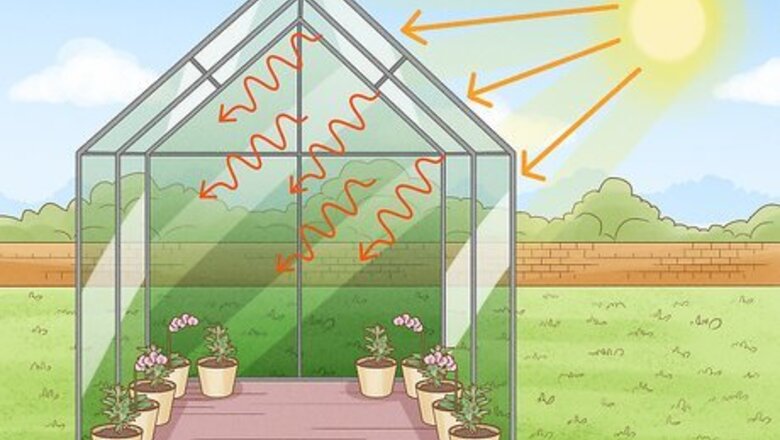
views
- Greenhouses absorb light from the sun. The plants inside convert that light to heat and slowly release it to warm the air inside the greenhouse.
- Build your greenhouse in a shady area if your home gets really hot in the summer months. Space heaters can help warm your greenhouse at night during the winter.
- Point your greenhouse toward the equator so it gets maximum sun exposure.
- Use your greenhouse to grow plants year-round or to start plants from seed early.
How Greenhouses Work
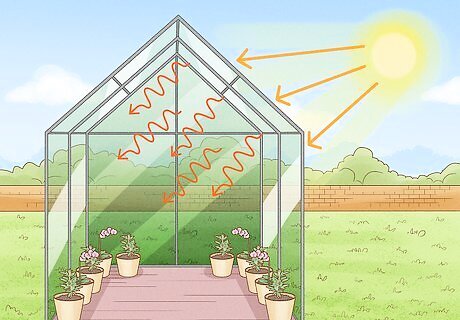
Light enters the greenhouse and is absorbed by plants and other objects. The roof and walls of a greenhouse are made of glass or transparent plastic sheeting that allows sunlight to shine through. The plants you're growing in the greenhouse, as well as any other objects, absorb the light energy.

Plants and other objects convert absorbed light to heat. When you stand outside on a sunny day, you can feel the light of the sun warming your body. The same principle is at work in a greenhouse—the sun's rays are absorbed by the plants and other objects inside, which convert that light energy to heat.
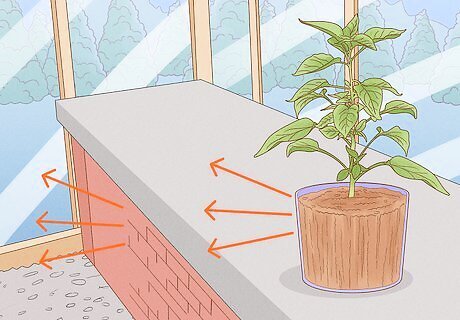
Plants and other objects slowly release the energy they've absorbed. When anything is heated by the light of the sun, it takes a long time for it to cool down again—just think about how warm it is inside your car if you leave it parked in the sun. As the plants and other objects in your greenhouse slowly release heat, they continuously warm the air around them.

The heat is trapped in the greenhouse, keeping it warm inside. Because heat energy has a different wavelength than light energy, it can't get through the glass or plastic barrier as easily as it came in. Some heat does escape, so greenhouses do need an alternative heating source in cold months—especially at night. But for the most part, the trapped heat keeps the greenhouse pretty warm. Ventilation is necessary in a greenhouse to circulate the air and bring in fresh carbon dioxide, which the plants need, from outside.
Controlling the Temperature in a Greenhouse
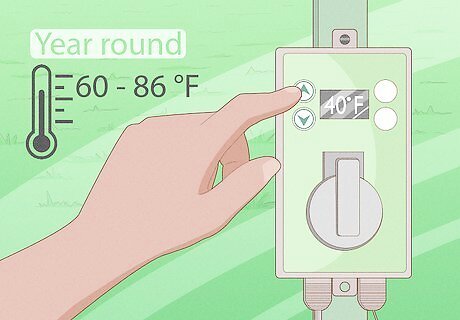
Maintain a temperature between 60 and 86 °F (16 and 30 °C) year round. While specific plants grow best at various ranges (and you should tailor your temps to your specific plants' needs), most plants grow best in temperatures that range between 60 and 86 °F (16 and 30 °C). You never want your greenhouse to get below 60 °F (16 °C) or above 90 °F (32 °C).

Use space heaters if you live in a cold climate. In the winter months, you'll likely have the opposite problem you did in the summer. Space heaters take over when there's less sunlight so you can maintain an optimum growing temperature. If you're not actually growing anything in the dead of winter, you don't have to worry about this. But it might still be an issue in early spring.
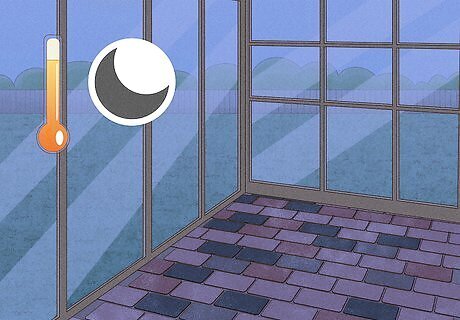
Lay a brick floor to help keep your greenhouse warm at night. Bricks have a high thermal mass, which is a scientific way to say that they absorb a lot of light and convert it to heat, which they release very slowly. For this reason, bricks are an excellent flooring choice if you live in an area that's cold much of the year. Brick benches or a brick wall add some aesthetic quality to your greenhouse as well as store energy to help keep your greenhouse warm.
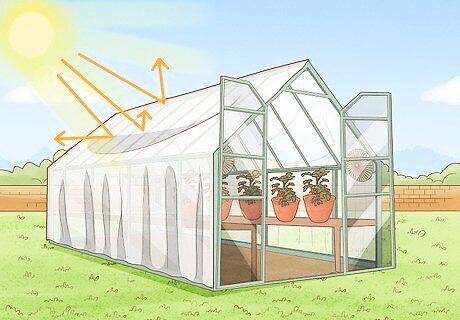
Cover the roof with white sheets to limit light in hot climates. White reflects sunlight, so white or pale-colored sheets or curtains keep too much light from coming in. On really hot, sunny days, this will keep it from getting too hot in your greenhouse. Greenhouse supply companies offer paint you can use to coat the roof. This is a less attractive option because the paint is hard to remove in the fall and you'd have to repaint every year.
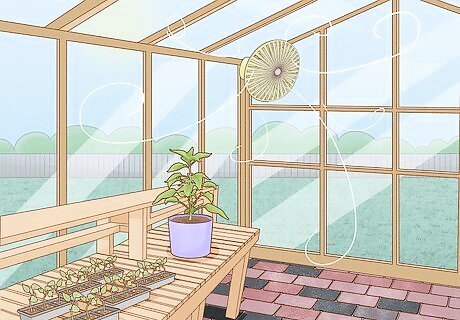
Add fans if it's still too hot even with ventilation. Ventilation fans are necessary to circulate the air and bring in fresh carbon dioxide from outside the greenhouse. They also cool the air a little, but their cooling effect likely isn't enough in the summer months. Additional fans will do the trick and are less expensive than a full-blown air-conditioning system. Experiment with combining different methods to keep your greenhouse at the temperature it needs to be.
Greenhouse Location and Orientation
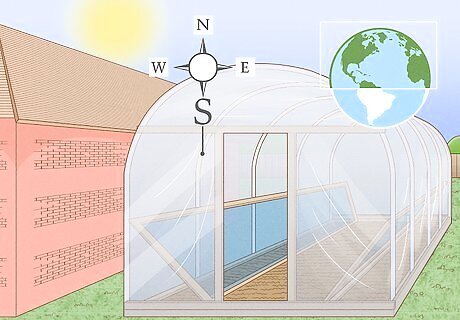
In the northern hemisphere, construct your greenhouse due south of another building. If you live in the southern hemisphere, on the other hand, construct your greenhouse due north of another building. This ensures that your greenhouse will get a long duration of sun exposure in the morning and afternoon as the sun rises. And since the sun hits the greenhouse first, it's not blocked or shaded by other structures. For example, if you live in the northern hemisphere, you might build your greenhouse in the backyard on the southern exposure of your house.
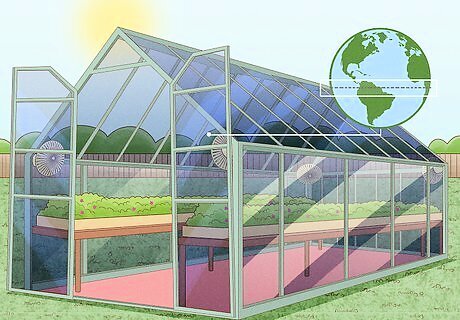
Point your greenhouse facing the equator for maximum direct sunlight. In the northern hemisphere, this means you want your greenhouse facing south—north if you live in the southern hemisphere. If a due south or due north orientation won't work in your backyard, face your greenhouse toward the rising sun so it gets more sunlight in the morning than in the afternoon (since morning sunlight is better for plants!).

Attach your greenhouse to another building if you live in a cold climate. Your greenhouse will get some of the radiant heat from the other building, which will help keep it warm during the winter months. Attached greenhouses are also a lot simpler and less expensive to build and maintain than free-standing structures. For example, you could build a small and simple lean-to greenhouse off the side of your house.

Protect a free-standing greenhouse from the wind with a hedge or fence. Wind can do more damage to your greenhouse than anything else. In relatively flat, windy areas, a fence or hedgerow serves as a windbreak to keep strong gusts from damaging the structure.
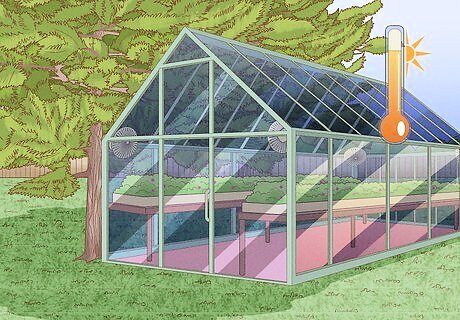
Place your greenhouse under trees if you live in a hot climate. Deciduous trees provide plenty of shade in the summer to help keep your greenhouse from getting too hot. In the fall, they shed their leaves to allow for maximum sun exposure just when your greenhouse needs it the most. Take into account the possibility of falling limbs that could damage your greenhouse, especially if you live in an area that's prone to severe weather.
What are the best plants to grow in a greenhouse?

Plants that require hot soil and lots of sunlight grow best in greenhouses. The truth is, you can grow basically whatever you want in a greenhouse—even plants that wouldn't normally grow in your climate zone. But it's better to pick a few easier plants to start with, especially if your greenhouse is very small. Here are some plants that you can grow in a backyard greenhouse year-round: Tomatoes Peppers Spinach and other leafy greens Cucumbers Eggplant
What is the greenhouse effect?
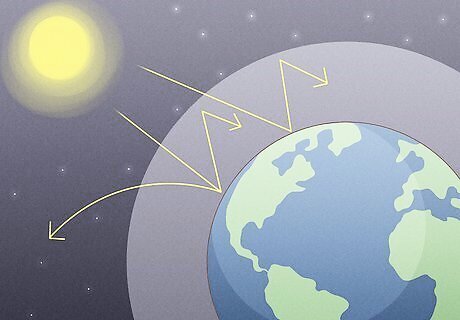
The Earth's atmosphere causes the planet to act as its own greenhouse. Greenhouse gases, such as water vapor and carbon dioxide, work the same way the walls of a greenhouse do, which is where the name comes from. These gases allow the sun's light energy to penetrate through to the Earth's surface, where they are absorbed and converted to heat. The greenhouse gases trap that heat, warming the Earth. The greenhouse effect isn't a bad thing in and of itself. The Earth's average temperature would be below zero if it weren't for this layer of the atmosphere. The greenhouse effect causes problems when there are too many greenhouse gases in the atmosphere. This causes the Earth to get too warm, leading to melting ice caps and other environmental disasters.










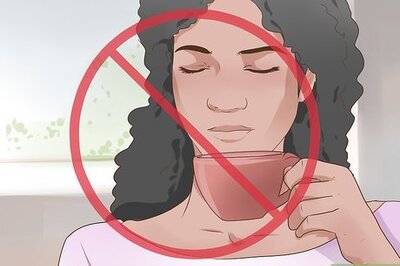


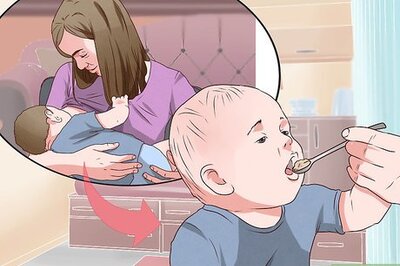
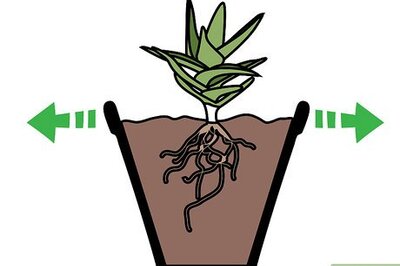




Comments
0 comment